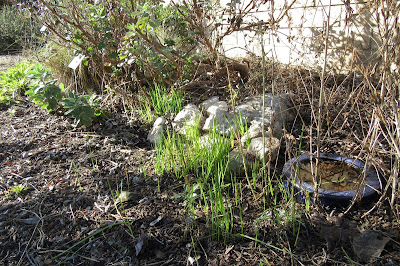 |
| Allium unifolium, one of the Western natives recently planted in Mother Nature's Montrose Garden. |
Perennials
from bulbs are true garden treasures.
The native varieties can be relatively inexpensive, particularly since
many reproduce readily from offsets and/or seed. They add a spot of color in early spring or
summer, and can be used to brighten areas of unrelenting green. And they follow
a schedule that reminds us of the seasonal cycle, giving us a treat to look
forward to, year after year.
Many
Western native bulbs are planted in fall. But you need to get your orders in
early (summer is best) to reserve bulbs for fall planting. Bulbs can be ordered
on-line from most sources. And bulbs are shipped in time for appropriate
planting, usually based on USDA Climate Zone.
Native bulbs can be challenging to find, particularly if you limit yourself to local natives. But some western bulbs are propagated by native plant growers – some are even available from the larger commercial bulb producers. For example, K. van Bourgondien, a Dutch bulb grower, offers Camassia quamash (Camas) and a few other western natives. John Scheepers offers Camas, Allium unifolium and cultivars of several native Brodiaea, in addition to the more traditional garden bulbs. Easy to Grow Bulbs also offers a collection of N. American species and cultivars.
 |
| Smaller Wild Hyacinth plants have naturalized from seed. |
Seeds for some bulb-producing perennials are available from on-line native seed sources (see Native Plant and Seed Sources page, right). Growing bulb perennials from seed takes time; many bulbs take three or more years to reach flowering size. But seeds may be the only option for some rarer native species. And while requiring patience, growing bulbs from seed can be a fun and inexpensive way to grow such intriguing native species!
 |
| Native bulbs can be grown from seed in pots. Many native bulb perennials also make great container plants. |
If you live in a cold-winter climate, it’s important to check the USDA Zone before ordering a bulb species. Many of the loveliest Western natives come from the West Coast. Not all are hardy in colder climates, so be sure to check. If a species is too tender, you can usually grow it in a container and overwinter it indoors. If you’re interested in West Coast species, here are some good sources of bulbs and seeds:
·
Teleos
Rare Bulbs (http://telosrarebulbs.com/index.html)
·
Seven
Oaks Nursery (https://www.sevenoaksnativenursery.com/)
·
Larner
Seeds (https://larnerseeds.com/)
·
Sierra
Seed Supply (http://www.sierraseedsupply.com/native_wildflower_seed.html)
·
Seedhunt
(http://www.seedhunt.com/california-natives/)
It’s also important to check the growth requirements before ordering bulbs. Many native bulbs like to be relatively dry in summer/fall, but there are exceptions. The summer-dry requirement is another reason to consider growing bulbs in containers. Most native bulbs like full sun, although some do well in part-shade. Most grow best with conditions similar to those in their natural habitat. So, be sure to order species that will thrive under the conditions available in your garden – or grow them in containers.
Bulb
growers ship bulbs at the appropriate time for planting. In our part of Western Colorado, that time is
early to mid-October, when soil temperatures are neither too warm or too cold. Of
course, sometimes we can be surprised by an early snowfall (above). So, it’s best to plant soon after the bulbs
arrive.
Lay bulbs out before planting.
Planting
bulbs is easy. The grower usually provides
advice on planting density and planting depth. If not, research the planting
requirements on-line. Lay the bulbs out on the ground where you want
to plant them (above). This allows you
to visualize their placement, adding or subtracting bulbs as needed.
Many
native bulbs are relatively small (compared to typical tulip or daffodil bulbs).
We find it most convenient to plant native bulbs with a pointed garden trowel
(above). Dig a small hole, the appropriate depth. Place the bulb in the hole, root end
down. Cover with dirt and press down
firmly with your hand. That’s it.
 |
| Dig a hole just big enough for bulb. Be sure the bulb sits at proper depth. |
Like
most seasonally-dormant plants, bulb perennials are best marked at the time of
planting. Otherwise you’ll forget their
exact location (trust me). For guidance
on how to mark your soon-to-be-dormant perennials, see: https://mothernaturesmontrosegarden.blogspot.com/2019/10/gardening-tip-mark-your-perennials.html.
 |
| Label your bulbs right away (so you know where they are located) |
And that’s all there is to it. Relax with your favorite beverage and dream about your spring garden. If you’ve chosen well, the native bulbs should multiply, providing an ever more impressive display over the years. For more on growing California (and other) native bulbs, see: http://mother-natures-backyard.blogspot.com/search?q=bulbs.
 |
| Native bulbs provide years of enjoyment. |
_____________________________________
We welcome your comments (below). You can also send your questions to: monaturesmontrosegarden@gmail.com






No comments:
Post a Comment